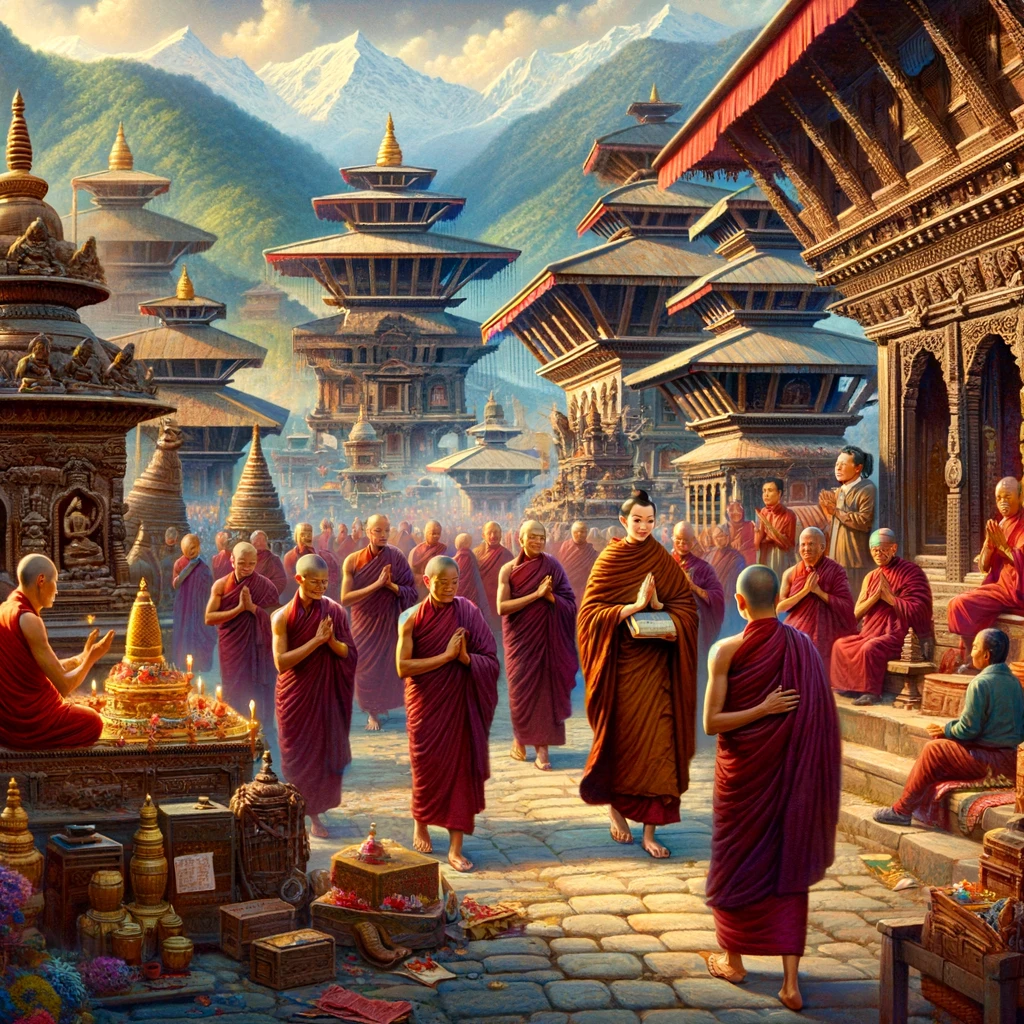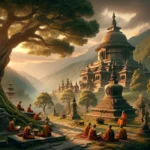Inscriptions on stone, metal and paper dating from the 10th century and becoming more frequent during the following centuries, also describe viharas and Buddhist activities. Among the earliest references to surviving viharas is an index compiled by the Tibetan monk Dharmasvamin lived in Nepal between 1226 and 1234 A.D.Publication of existing epigraphic evidence on the medieval history of Central Nepal is not yet completed. Still, it is the medieval period of which has had the greatest impact on the formation of the Newar Buddhism. Therefor about central Nepal I intend to discuss more things under heading of Newar Buddhism. Here we discuss mainly on Buddhism in western Nepal.
After the 10th century C.E. political history events become obscured in the Kathmandu Valley for a few centuries.During the same period we see a strong political state emerging in the far western part of Nepal. Concerning Buddhism, however, it flourished for a few centuries due to the patronage of the kings of the Nagaraja dynasty and their subjects. An historical sketch of Buddhism in western Nepal or this period based on inscriptions follows.
An inscription found at Dullu is very important. It was erected by Prthvi malla belonging to Nagaraja dynasty in 1357 CE. It shows that the kingdom was established for 11generations back by Nagaraja. Therefore it was probably around beginning of the 12th century.
King Kracalla, the sixth generation of the Naga dynasty composed a long inscription found at Balasvara, Kumaum, India. He described himself as a Paramasaugata or “the greatest devotee of the Buddha.” He also portrays himself as a Danasilaparayana or endowed with acts of offering and good virtues. Such terms reveal that he was exclusively Buddhist. Yet he also held respect with other religions and offered donations and constructed temples.
A Balasvara inscription of Prthvimalla describes king Asokacalla, the son of Kracalla, as spreading mercy far and wide. There are a few inscriptions attributed to him but doubt their authenticity. We shall there fore discuss only those inscriptions which are agreed upon by all. An inscription by Asokacalla found Buddhagaya, India states:
“This offering is done by a follower of the good Mahayana school, a great devotee (Upasaka), endowed with all virtues, the great King Sriasokacalladeva. This vihara was constructed by the King as a result of the scholar from Kasmira, Venerable Gucapathi, also the Rajaguru Pandita Musala, and officers Sankaradeva and Trailokyabrahma, advising the king whereby the king commissioned Bhatta Damodara, Bhatta Paduma and officer Raghava Mahipukala to do the work.”
The King’s brother also had inscriptions executed at Buddhagaya. This attests to the King being exclusively Buddhist and the ruler of “125 thousand mountains” of Khasa Desa. The younger brother, prince Sahanapala, who was responsible for the King’s treasury, was endowed with good virtue and is a follower of the Bodhisattva ideal, and made the donation Buddhagaya. The honorific titles given to King Asokacalla ( 1275 CE) in both inscriptions reveals that he was a follower of Mahayana Vajrayana Buddhism.
According to the Dullu pillar inscription of Prthvimalla, Asokacalla had a son named Jitarimal1a. According to the chronicles King Jitarimalla came to the Kathmandu Valley at least three times and offered donationsto important Buddhist sanctuariessuch as Svayambhu Caitya in Kathmandu and the Bungamati temple of Lokesvara in Patan.
King Ripumalla travelled to the Kathmandu valley in 1312 CE. He worshipped the Svayambhu and offered a feast to all monks initiated there. Mr Dhanavajra surmises that the king might have travelled to Lumbini and Kapilavatthu a shortly after or before his visit to Kathmandu as there are inscriptions of the king also found at Lumbini and at Kapilavatthu Niglihava dated within the same year.
King Pratapamalla was the grandson of King Ripumalla. The inscription by Prthvimalla at Dullu describes him as having renounced lay life. Mr Dhanavajra Vajracarya surmises that the king might have ordained as a Buddhist monk as a whole. He gave the throne to Punya malla from the Pala dynasty, who was perhaps his son-in-law.
Punya malla was the father of king Prthvi malla who had erected the pillar inscription at Dullu. The pillar offers the chronology of his predecessors and himself. In a silver inscription dated 1336 CE he states that he has successfully saved the kingdom founded by the grace of the Buddha. On another silver inscription dated 1337 CE he is described to be paramasaugata, or the greatest devotee of the Buddha. This shows that he felt extremely proud to state that he was Buddhist. He also invoked the Buddha, Dharma and Sangha on the pair of his silver inscriptions cited above, tobe witness to his activities.
King Prhhvi malla also followed his predecessors. His inscription at Dullu, begins with ‘aum manipadmehum’ a famous Buddhist mantra of universal protection and states that he exempts all Buddhist monks in his Kingdom from all kinds of taxation. There was a position of Dharmabhanaka (teacher of Dharma) of Buddhist monks in his country. Some of his ministers also founded caity as andviharasinthe kingdom.The Triple Gem, that is to say, Buddha, Dharma and Sangha, are invoked frequently as witnesses on his inscriptions. According to his silver inscription of 1359 CE, he also stated that he had successfully saved the kingdom founded by the grace of the Buddha. He also invoked the Buddha,Dharmaand Sangha aswitnesses to his activity.
Abhayamalla was the son of Prthvimalla. His silver inscription of 1376 CE invoked the Triple Gem of the Buddha, Dharma and Sangha to be witnesses. He also boasts that he has control a group of the kings and possessed a large army and a herd of foreign horses. This proves his kingdom was not small.
A silver inscription of about 1393 CE shows a new name and ruling dynasty over Dullu called Samsaravarma. Another silver inscription of 1404 CE shows another King Baliraja was ruling at Jumla with the king Medinivarma. It is surmised that they were probably dukes under the Malla dynasty; but when they found an opportunity they replaced the dynasty by some unclear means. Then they became independent.
Many social changes took place in time and by some sort of metamorphosis and Buddhism in any form disappeared for good in the beginning of the 17th century C.E.. This is reflected in the Tamrapatra (copper plates) of the day, which make no more obeisance to the Buddhist trinity as was the practice earlier. In this way ends the history of the Buddhist kingdom of Sinja in Western Nepal. A Tamrapatra or copper plate inscription by Sailamsahi belonging to the Raskoti family and Kalyaraja Maharajadhiraja Vikrama Saha in the year of 1620 CE (Saka Sambata 1542) reveals the fact.
Inscriptions reveals that all the Calla ana Malla dynasty Kings of the Sinja Kingdom were Buddhist. Not only the kings but also their ministers and other retinues as well. Inscriptions found at Dullu state that at Sinjapuri (city) there were large monasteries and temples with golden pinnacles. This kingdom emerged as a safer place for the scholar monks who fled from India since the eleventh century under the threat of Islam. Accordingly, the Dhanavarja Vajracarya, inscriptions show their composers to be well versed in the Sanskrit language. Archeological remains scattered about a vast area at Surkheta district called Kankre Vihara or Kankre monastery is surmised to be of this period. Many archaeological items found there proves it to be an ancient Buddhist area. The present ruling class of Nepal also is surmised to be the same stock with the Khasa Kingdom.
The Terai region of Eastern Nepal must received strong Buddhist enfluence from Pataliputta , the capitsl city of the Emperor Asoka, and Buddhsim was alive up to 15th century A.D. but difficult to locate as no tradition or inscription are remined and nor there any significant Buddhist holy place. Prior to its annexation with modern Nepal in the beginning of l8th century C.E. eastern Nepal was divided in many local tribal feudatories; Chaudandi, Timala, Limbuan and Vijayapura etc.Very littleisknown about the history of this area before annexation. Northern part of this area was under regime of Tibet.As the result, Tibetan culture and religion hada deep effect on its inhabitants. There are some important Mahayana monastery and nunneries.Some parts of eastern Nepal received much more Buddhist influence having been under Sikkim, king of which was follower of Buddhist religion. The non-Aryan people of this area are rather far from Brahmanistic influence,compared to the Kathmandu Valley and other parts of the country. This is also main abode of the Tamang, the biggest Buddhist group of the country, and the Lepchas. Since annexation with modern Nepal Buddhists of this area came under a Brahmanistic constitution.
The most important factor in the history of Buddhism in modern Nepal is the plan of His Majesty’s Government to develop Lumbini, the birthplace of the Buddha, as an international centre for pilgrims, Buddhist scholars and students. Since 1895 when the Asokan pillar at Lumbini was discovered, this place began attracting tourists and pilgrims. Plans to develop this sacred site on a grand 770 hectares scale have been in existence since 1968.The “Lumbini Development Project”with the participation of the United Nations, and a number of South and Southeast Asian countries together with Japan, constitutes one of Nepal’s largest development projects. Progress however, has lagged behind the plans and was therefore reorganized in l986 as the “Lumbini Development Trust”. With the restoration of democracy in the county the trust had also to change its executive board according to the parties in power. Since 1993 the trust began to distribute land to different Buddhist groups, according to allotment in the master plan. Numerous Buddhist groups from different parts of the world at both government and non-government level have established large Buddhist monastery and sites there. They consist of every sect of Buddhism in the world. Thailand performed a stone laying ceremony at the end of 1995.
Now the Lumbini is a very important Buddhist center where all sects of Buddhists gather. It also is a most significant centre of religion and culture of Nepal and inspires all Buddhist groups of the country.


